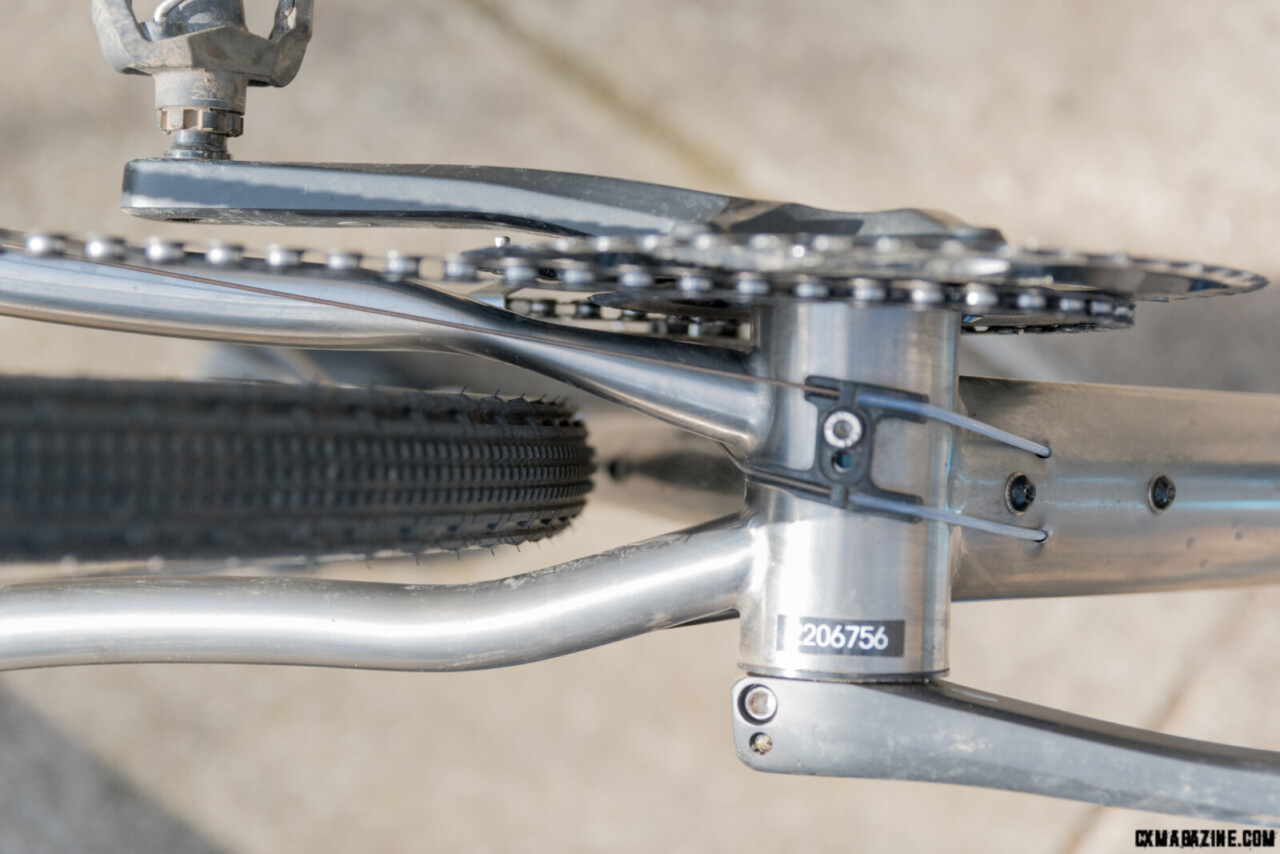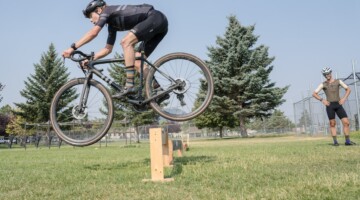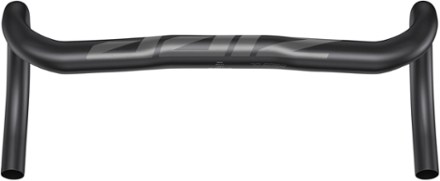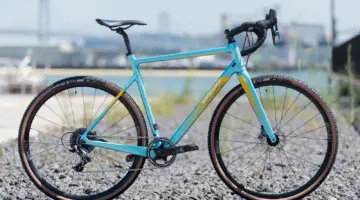T-Lab in Montreal, Quebec, Canada is a relatively new producer of titanium bicycles. The X3 is their first bike and remains a flagship of the T-Lab lineup. T-Lab’s founder and team members are not new to bicycle manufacturing. Several came from the custom high-end brand Guru Bikes, a company that had prominence in North American custom bike manufacturing, from the mid-aughts until 2015. T-Lab has no further connection with Guru.
We saw the T-Lab X3 at the 2019 North American Handmade Bike Show in Sacramento, California. The X3.22 is the update and upgrade to the original model. T-Lab builds bike frames only with titanium and uses some unique manufacturing techniques. We put the new X3.22 to the test. Read on to see if it’s the right bike for you.

T-Lab X3© C.Lee/ Cyclocross Magazine
A titanium bike is expensive. Titanium alloys are expensive and are notoriously expensive to work with. The hard material takes longer to cut and shape and wears out expensive cutting tools. However, the material also has many desirable qualities for a bicycle frame, especially a gravel bike frame subjected to rough terrain and harsh weather. T-Lab believes in the advantages of the wonder metal and devotes a webpage to explaining its benefits.
For many, carbon fiber composite sits at the top of the bicycle performance pyramid because it is light and stiff. The process of making a carbon composite bicycle frame is such that shape and fiber orientation is relatively easy to manipulate and provide the desired characteristics. It is difficult to customize metal bike frames in a similar fashion. Impact resistance and resultant catastrophic failure seem to be the downfall of carbon fiber composite for bicycle construction.
High stiffness-to-weight ratio, great resistance to corrosion, impact and fatigue make titanium alloy seem like the ideal material for a metal bike frame. The touted durability makes the cost of a titanium bike frame a good value if the design and execution work well for you.
Execution is the key to any bike frame. I have ridden great and poor examples of bikes made from every material, so was eager to ride the T-Lab X3 to see how it stacks up against other titanium bikes I’ve ridden from other good titanium builders such as Moots, Mosaic, Sage, Lynskey and Seven.
T-Lab Morphology
Metal bikes use metallurgy, tube thickness, and shape to alter the ride quality. Modern aluminum alloy bikes with good engineering and manufacturing techniques offer a remarkable ride compared to bikes of the same material 2 decades ago. The Trek Crockett is a good example of this. Titanium is a difficult material to shape, but T-Lab has a proprietary method to mold the Grade 9 titanium (3Al/2.5V) titanium alloy into complex tube shapes. The goal is to tune the ride quality.
The top tube is quite flat but flares at the seat tube junction. The down tube is a very slight vertical oval at the headtube junction but is quite horizontally flat at the bottom bracket shell. The seat tube is also horizontally flat at the bottom bracket. The bottom bracket shell on our review sample is 86mm wide for PressFit 386 although a T-47 threaded bottom bracket shell is available. The T-47 is 68mm wide, and presently T-Lab does not offer the option for T-47 internal.

The bike has plenty of clearance around a 38mm Panracer GravelKing, Maximum recommended tire clearance on the T-Lab X3 is 45mm. © C.Lee/ Cyclocross Magazine
The wide PF 386 bottom bracket stance yields wide tire clearance, up to 700C x 45mm officially. Given the observed weld points, using a 68mm wide T-47 bottom bracket shell shaves 9mm off each side. By my estimation, this would not change the profile or placement of the tubes, though the weld zones of the chainstays would be close to the outer edge of the bottom bracket shell.
The headtube is a three-piece construction. Metal headtubes are often machined from a billet of material with a lathe and mill. That is time-consuming and wastes a lot of material. Three-piece construction has far less weight, is faster to weld and finish, and is lighter, according to T-Lab.

A three-piece headtube saves a lot of machining. © C.Lee/ Cyclocross Magazine
The rear triangle of the X3.22 has a wishbone-style seatstay, new in 2022, hence the model designation. Consistent with T-Lab’s goal of eclipsing and surpassing the performance of any bike in its category, the design change achieves better ride quality and pedaling efficiency, according to the company. It certainly gives the bike some uniqueness.

Interesting tube shapes and attachments on the T-Lab X3. © C.Lee/ Cyclocross Magazine
Also unique to the T-Lab is the T-One machined aluminum axle holder system that includes the derailleur hanger on the right and the brake caliper flat mount on the left. The system “future-proofs” the frame in the case that axle size or spacing, brake caliper mount standard, or derailleur hanger standard changes. Our sample came with a flat mount, compatible with a 140mm rotor. The standard specification is now for a 160mm rotor.

The bolt-on one-piece axle and caliper mount of the T-Lab X3 is the default for a 140mm rotor. Access to the front caliper mount is blocked, so an 8mm hex-head cap screw replaces the usual Allen head bolt. © C.Lee/ Cyclocross Magazine
The interesting thing with the X-One system is the chainstay blocks access to the forward rear caliper mounting bolt. The solution is a hex head machine screw. This necessitates an 8mm open-end (or box end) wrench that one does not always carry in the field. Just ascertain if it’s tight before a long ride.
Geometry
The T-Lab X3 webpage shows the standard geometry of the X3.22. Our 56cm sample demonstrates the X3.22 all-road geometry to be nothing outrageous. It has a 56.6cm effective top tube length combined with a 160mm headtube to give a 585mm stack height and a 389mm reach. The bottom bracket drops 7.0cm. The chainstay length is 42.6mm and the headtube angle is 71.5. With a 620mm front center, the total wheelbase is 103.6. The T-Lab custom fork offset (rake) is a long 52mm yielding a 63mm trail figure with a 38mm tire in place. Cannondale uses similar front-end geometry to put the front wheel further forward yet maintain a quick-steering trail figure. Gary Fisher brought this front-end geometry to light in 1998 as part of his Genesis design.
Frame Options
Our review bike has a “Hue” finish upgrade (USD 550) with a brushed tube surface and bead-blasted graphics. A bit of extra polish enhances the already-beautiful welds. A sky blue painted fork and matching seat tube accent complete this upgrade.
Provisions for racks, fenders, and three bottle cages are on the review sample frame and fork. Each set of bosses beyond the two standard main-triangle bottle mounts is a USD 125-175 upcharge. Each blade of the all-carbon T-Lab X3.22 fork has 3 standard mounts for different cages. The fork has a provision for internal dynamo wiring and a threaded headlight mount is on the front of the fork crown. The back of the crown has a threaded fender mount and fender stay mounts are on the inboard side of the fork blades. The option exists for a fork with no mounts if you want a different aesthetic.
Custom geometry is an option with either information from a professional bike fit or photos and descriptions of your fit on an existing bike. There is no published option for a dropper-post control line.
On our review sample with a mechanically shifted drivetrain, control lines run internally through the downtube only before exiting in front of the bottom bracket to run externally to their destinations. However, when ordering the frame, you can specify Shimano Di2 or SRAM eTap setup.
T-Lab frames are made-to-order with an approximate 6 to 8-week turnaround time.
T-Lab X3.22: The Build
Our T-Lab X3.22 review bike is entirely equipped with Shimano GRx 800 series 11-speed drivetrain with a double crankset. The rear derailleur is the RD-RX810 with a maximum recommended rear cog of 34 teeth, compatible with a double front chainring. The FC RX810-2 double crankset has a (trendy, shorter) 170mm arm length and a 48-31 teeth chainring combination. The GRX front derailleur FD RX810F uses Shimano’s toggle link that does not interfere with tire clearance as the previous swing arm design did.

Shimano GRx 2X11 speed mechanical drivetrain on the T-Lab X3.33 © C.Lee/ Cyclocross Magazine
The toggle link front derailleur looks more complicated than it is. The swingarm is shorter and further forward, and the cable routing is a bit different. Shimano added a cover that helps keep the derailleur cleaner and the free cable end wrapped up and out of the way.
Wheels and Tires
Shimano WH RX570 is the aluminum GRX wheelset on the T-Lab X3.22 review bike. There is a carbon version that shares all the components except the rim. The aluminum rim is 21.6mm in internal width and is 22mm deep with a 26mm outside width. 24 straight-pull bladed spokes lace the rim to the Shimano 12mm through-axle center lock hub. The spokes have external alloy nipples and are not intertwined at the crossings, something I discussed in the recent review of the Lōgōs Epoché wheels. I did not find this 1700-gram wheelset anything extraordinary except that they are an uncommon sight in the wild with so many wheel choices, but are a narrow but decent value as a separate wheelset. They retail for $430 but are often discounted to $300.
Shimano continues to use cup-and-cone bearings that are easy to service and adjust if you know how to do that. It is essential to regularly inspect and service the bearings since the bearing races are not replaceable. In some ways, cartridge bearings have an advantage. Shimano cup and cone bearings have angular contact seals and a good long history of durability in my experience.
Shimano invented the freehub and GRX follows many of the original designs with axle bearings at the outer edge of the steel freehub body. This gives good support for the aluminum axle. Shimano freehubs are meant for replacement rather than service, even if that is technically possible. I cannot verify how many pawls the freehub has, but I measure 20 degrees of engagement.
700C X 38mm Panaracer GravelKing SK tires measure true to size on the Shimano WH RX570 rims even with the relatively narrow internal width specification. The rims are pre-taped for tubeless compatibility, so we removed the tubes and easily set the tires up tubeless. Panaracer has always been a reliable tubeless tire in my experience, even in the days of tubeless conversions when true tubeless compatible tires were rare. The GravelKing SK has a tread that is more robust than a file tread, so a good choice for generally mixed terrain that does not include mud or very loose conditions.
T-Lab X3.22: Touch Points
Selle Italia Model X Boost saddle is 145 mm wide at the rear and a relatively short 245mm from nose to tail with a large center cut out for pressure relief. The saddle materials are recyclable and use no glue for construction. The saddle rails are a steel alloy.

Selle Italia Model X saddle atop the Zipp Service Course seatpost. © C.Lee/ Cyclocross Magazine
Zipp Service Course SL70 Xplr aluminum handlebar, is 42cm center-to-center at the hoods. The 3-degree back sweep of the top section is a popular design feature from the past. The 5-degree flare towards the drops is hardly noticeable. The bar oddly sweeps outward 11 degrees only at the end of the drops, giving it a unique appearance.
Zipp aluminum alloy Service Course 27.2mm diameter seatpost and 10cm stem complete the component package.
The weight of the complete bike is 19.7 pounds, 12.4 pounds without wheels.
T-Lab X3.22: The Ride
Evaluating the ride of a bike is completely subjective. I don’t own the bike, so there is no confirmation bias here, and even though T-Lab kindly sent the bike out for review, I have no incentive to bias my review in any way. I rode the T-Lab over the same roads and trails as other bikes I’ve reviewed. This includes a lot of underbiking on cross-country single-track trails, often quite rocky or rooted. Of course, I rode the T-Lab on my cyclocross course that has grass, sand, off-cambers, and this year, mud from California’s late winter and spring rain. Much of the riding was on gravel and fire roads. I weigh 155 pounds and consider myself a fairly ‘light’ rider, meaning I don’t bash rocks or drop down hard on the trails.
Bike set-up biases subjective review. Frame geometry, frame material, and components are influences, I think in that order. I made sure the bike closely matched my preferences, and later in the review changed the stem length and the saddle for better comparison to other bikes I like.
I liked the T-Lab X3.22 from the first ride. The handling is immediately familiar and after a few rides, I reviewed the geometry and understood why. The X3.22 has fairly standard modern geometry to modern cyclocross bikes. The front end is not extraordinarily long or slack. Chainstay length of 42.6mm is on par with most dedicated ‘cross bikes today. Even the bottom bracket drop is standard for American ‘cross bikes.
The T-Lab’s road manners are quite good and neutral. It tracks easily and leans into corners intuitively. Standing on the pedals to sprint or climb feels good, but the X3.22 might not have the snap of some other super stiff bikes. I felt the same during seated accelerations on a climb, it responds just fine but does not have the get-up-and-go feeling of shooting out from under you with each effort. Rather, it is a smooth and efficient transition. This is a quality I’ve experienced with other titanium bikes with one or two exceptions. Of course, I’ve tried to take into account wheel weight, tires and tire pressure.
The transition from pavement to off-pavement at speed gives me some semblance of the front-end stiffness. Did the abrupt surface and speed change throw me off my line? The T-Lab handles this with aplomb. It’s not a soft transition, but it stays on track. The X3.22 is not silky smooth on bumpy tracks, rocks and roots, transmitting the hits through the bars, but again it stays on its line and damps the hits well. On a surface that creates a lot of vibration such as washboard or rough pavement, the T-lab mutes the chatter well. To verify that perception is not strictly related to tire type or pressure, I swapped wheels and tires with other bikes for comparison.
I cannot describe the ride as lively or silky, just efficient and smooth. The X3.22 ride quality is quintessentially titanium. T-Lab did a great job creating an efficient ride while maintaining titanium’s vibration-damping quality.
T-Lab X3.22: Component Selection
We published a review of the Shimano GRX components in 2019. I also made some observations about the 1X version in the review of the 2022 Trek Boone cyclocross race bike. The double chainring version makes the chain line issues in low gear much better. The double-chainring drivetrain is quieter and shifts flawlessly. Shimano perfected front shifting a while ago, and with the GRx RD810 that has a clutch, I never dropped a chain.
The gear ratio is 4.36 (118 gear inches) at the high end and less than one-to-one on the low end at 0.9 (25 gear inches). With double chainrings, there are essentially 16 discrete gears in reasonably small steps. This is an excellent gear selection for this all-road bike.
I thought the Panaracer GravelKing SK 38mm tires are also a great specification on the X3.22. The knob height and row pattern reduce rolling resistance and minimize road buzz on the pavement while providing a decent grip on various dry off-pavement surfaces. Perhaps the next wider size would be more versatile given the minimal knobs. Alternatively, I could put inserts in the tires to run them softer for more cushion and traction in certain technical situations. There is no true all-around tire but this one covers a lot of ground.
The Selle Italia X Model saddle and I did not get along, but saddles are a very personal choice. I like the Zipp Service Course Xplr ergonomic handlebar conceptually. I have always liked the slight back sweep of ergonomic bars. I never find I need or desire a flared bar, however. If anything, I want the drops to be narrower since I’m down there for aerodynamics! The particular outward sweep at the end of the bar feels unnecessary for me, but it offers something different if you’re in the drops for the long haul where you don’t need access to the brakes.
The GRX RX570 wheels are portly and narrow for a gravel wheel nowadays, but they work. Shimano road-type hubs have 18 points of engagement and ratchet up every 20 degrees. For technical terrain, I prefer a faster engagement of 10 degrees or less even if there is a bit more friction. Shimano should use their Quick Engagement mountain bike hubs that have 10 degrees of engagement on the GRX wheels. The Shimano GRX RX570 wheelset is not the basic listing on the T-Lab order page but is essentially equivalent to the Boyd GVL wheelset listed on T-Lab’s website.
T-Lab X3.22: The Verdict
The most basic X3.22 frameset is USD 3975. As equipped, our complete review bike is USD 6500. The frameset has the addition of braze-ons for an extra bottle, fenders and racks, as well as the Hue LX finish. The build is a complete Shimano GRX 810 groupset, basic wheels and Zipp Service components. That is not a small amount of money, but it is par for a handcrafted made-to-order complete titanium bike.
The T-Lab X3.22 has a unique look with multiple tube shapes not typically seen on a titanium bike. Titanium, like any material, has its resonance and inherent ride quality. Every bike builder finds ways to tune the ride by manipulating the material and construction, yielding a ride unique to the brand. T-Lab does a great job creating a beautiful-looking, fine-riding titanium gravel bike with the X3.22. If you love titanium’s scratch, dent and corrosion resistance, and like the titanium ride quality, the T-Lab X3.22 is one to check out. Too bad we have to send this one back.
T-Lab X3.22 Bike Specs:
MSRP: $6500 as tested
Frame: Grade 9 (3Al/2.5V) titanium
Fork: T-Lab XD with mounts 55mm offset
Weight: 20.4 pounds, as tested with no pedals; 12.1lbs without wheels or pedals
Shifters: Shimano GRX 810 hydraulic mechanical 11 speed
Crankset: Shimano GRX 810 48-30T double chainring
Brakes: Shimano GRX Shimano RT-800 rotors 160mm front, 140mm rear
Cockpit: Nukeproof Horizon 6cm stem, 46cm bar, aluminum
Seatpost: Zipp Service Course aluminum 2 bolt, 27.2mm diameter
Saddle: Selle Italia Model X, steel rails
Wheels: Shimano GRX WH RX570, 21.6mm inner width aluminum
Tires: Panaracer GravelKing SK 700X38 tubeless compatible
Warranty: Lifetime to the original owner, frame and fork
Country of origin: Canada
More Info: t-lab-bikes.com
































